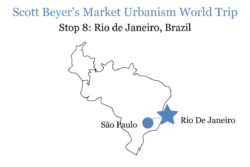How to Create an Urban Amenity Beach
Latin American beaches might be even better with private management.
During my Latin American travels, I’ve visited some of their famous beaches. And they’re famous for a reason: great weather, turquoise waters, and stunning rock outcropping views.
But much as I enjoyed them, I wonder, could they be better? After all, these places are major tourist attractions, yet they don’t provide an optimal stay for visitors. Businesses could better provide services, such as bathrooms, lockers and restaurants. And broader privatization could produce whole new amenity-filled experiences not now associated with public beaches.
Most people think of going to the beach to experience nature, but the LatAm ones I visited were urban. Copacabana in Rio de Janeiro was originally a small, remote beach for fishing. Roads, a promenade, and hotels were built and it became a tourist attraction. In the 1970s, a large landfill was added. That extended the width of the beach, allowing it to accommodate more visitors and infrastructure.

Copacabana is connected to two other beaches, Ipanema and Leblon. I found that all three had pretty good amenities. There’s lots of commerce nearby: high rise hotels, restaurants, clubs, stores, tourist information stands. And there’s lots of activities on the beach, like volleyball nets, frescobol courts, and gyms. You can rent bicycles and scooters. Vendors sell drinks, food, beach chairs, and umbrellas. Bathrooms are maintained through small fees, and there are free public showers.
Unfortunately the high number of tourists also attracts thieves. Because there are no lockers or other private spaces to stow things, it diminishes the pleasure of visiting.
South of Rio is another beach city, Balneario Camboriu. It has another “unnatural” beach. The city has 145,000 people, but during the summer population can exceed 1,000,000, as evident in the city’s massive skyline (it’s been called “the Dubai of Latin America”). Those towers cast shadows on the beach, so the city decided to expand its size. The city also wanted to counteract erosion and create more space for parks, sports, and places to eat and drink.
In 2021 they expanded the beach through dredging, taking it from 82 feet to 229 feet at a cost of $12.6 million. It’s the biggest beach I’ve seen, but has too much open space.

I also visited a few other famous neighborhood beaches in Montevideo, Uruguay. The crescent shaped beach, Playa de los Pocitos, has beautiful views but not much else. Despite being packed on a Saturday, it lacked amenities, with few toilets, showers or retail. Some of its beach houses were even shuttered, representing a huge lost opportunity.
While all three beaches – in Rio, Montevideo, and Balneario Camboriu – were nice, they begged the question of how much nicer things could be if they were privatized.

A fourth beach I visited gave insight into that. Florianopolis, Brazil has a neighborhood called Jurere Internacional that is privately-owned, having been acquired by Grupo Habitasul. While Jurere’s beachfront is still open to the public, the company reserved land just off it for five beach clubs offering food and nightlife. Jose Mateus, head of business operations, says the clubs are among the best-performing assets in their Jurere portfolio – and bring lots of life to the beach.
Some minor level of privatization could, as it has in Jurere, increase the amenity level of LatAm beaches. By law, all beaches in Brazil are public. Some politicians in Brazil want to change that. They proposed privatizing 10% of them to create special tourism zones. Developers could use that land to build hotels, casinos, private parks, clubs, and marinas.
Not everyone is on board. Opponents cite environmental concerns, like the impact of lights on migratory birds. Developments can also increase coastal erosion. Others don’t like the idea of restricting access to a group of people only interested in profit.
In a minor version of privatization, called a public-private partnership, beaches would remain open to the public but certain areas could be leased to commercial interests. Rather than a zero-sum outcome in which some profit at others’ exclusion, these interests would further activate the beach and provide services that people need (such as storage lockers). It would be a good alternative to the tragedy of the commons that now results from public management, with no incentive to develop any services beyond the bare minimum, because no one can profit.
Public-private partnerships, while rare for beaches, work in America. In Panama City Beach, the city partnered with a local company to put more lifeguards on the beach. Alabama worked with a private company, American Roads, to add a third lane to a bridge that provides beach access. Officials say the partnership is better because the private company can recoup road maintenance costs through tolls, instead of from taxpayers.
A more thorough version of beach privatization may sooner happen in private cities. There is now much investment going into beachfront charter cities (Prospera in Honduras being one famous example). This could open lots of experimentation into the beach-as-a-service concept, with private service providers offering amenity-rich experiences that fully monetize these valuable spaces.
The winner will be the “consumer.” i.e. the people going to the beach.
All images credited to Scott Beyer and The Market Urbanist.
Catalyst articles by Scott Beyer | Full Biography and Publications
